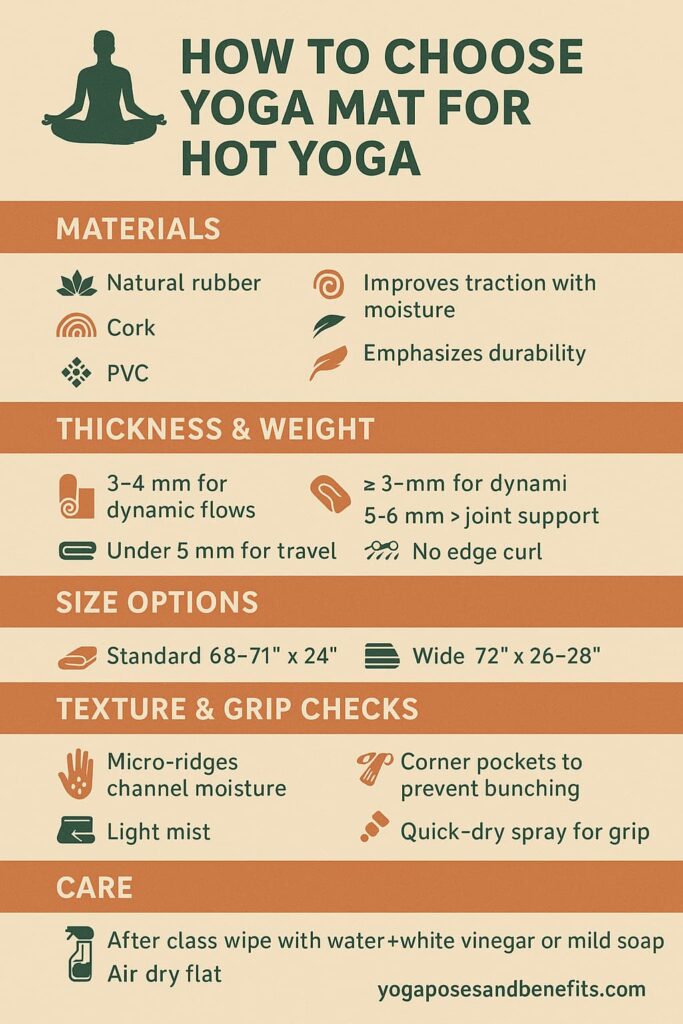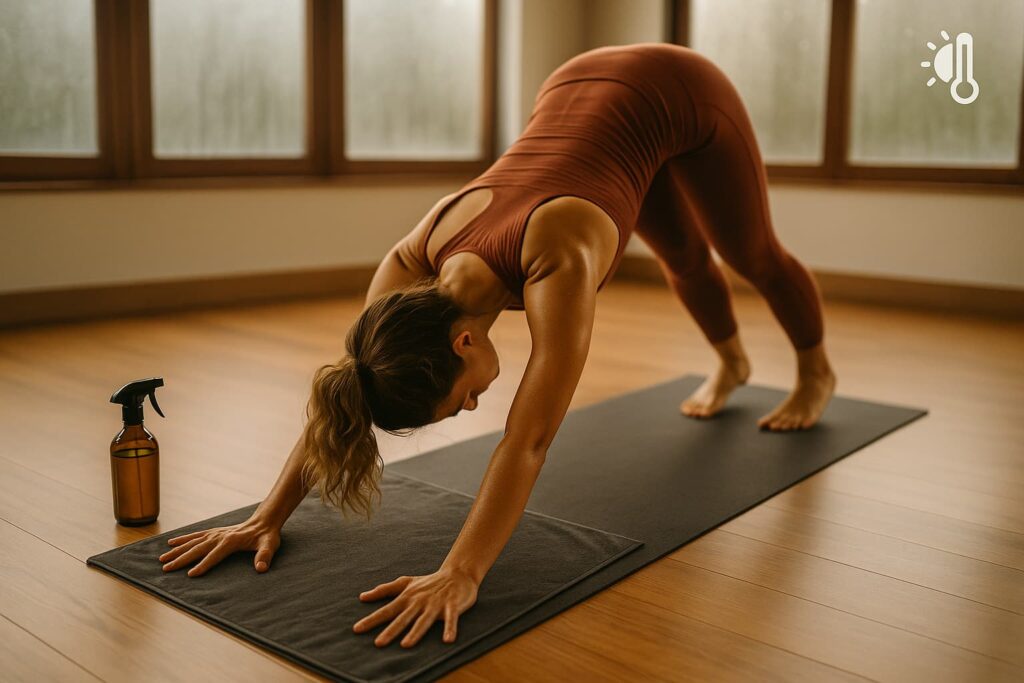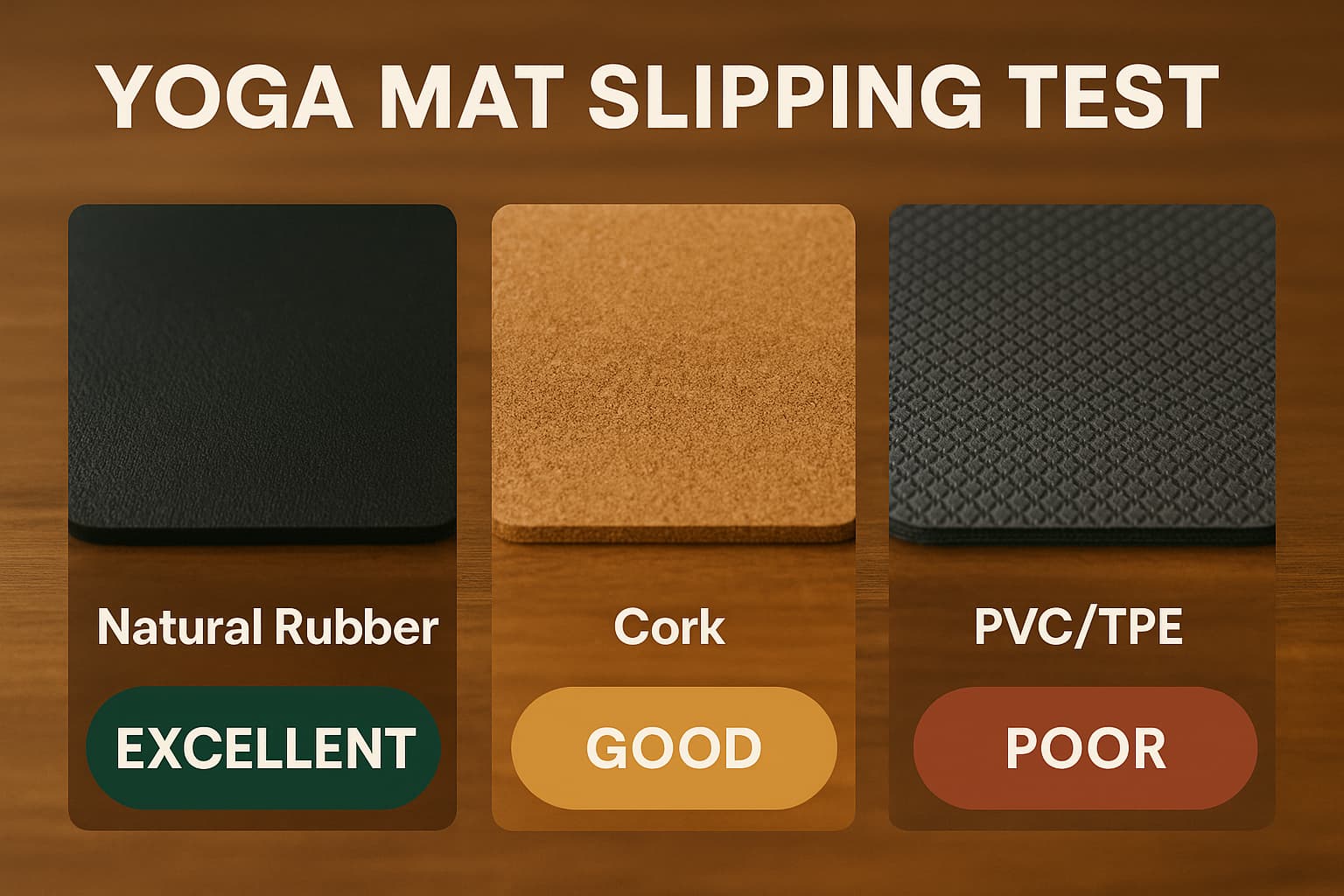How to choose a setup for hot classes
Start by ranking needs for hot yoga: dependable grip, joint cushioning, and carry weight. In heated rooms (Bikram often runs near 105°F/40°C humidity), a yoga mat must hold traction when damp, stay planted on hardwood or tile, and dry fast between classes. Test in real conditions: run a short Sun Salutation (Surya Namaskar) and include Downward-Facing Dog (Adho Mukha Svanasana) and Plank (Phalakasana) to feel bite under load. If sustainability matters, compare eco options that balance performance and responsibility.
- Map your format (Bikram, Vinyasa/Power) to sweat rate
- Target thickness for joints; confirm the underside won’t skate on studio surfaces
- Shortlist two or three yoga mats and compare odor, weight, and cleanup
Consider a wide mat (26–28″) if your stance needs room; standard lengths run 68–71″+. Choose the setup that preserves stability, simplifies hygiene, and lets breath cues (ujjayi) and drishti lead your practice—not slip management.
Mat materials for heat, sweat, and hygiene
Natural rubber delivers confident grip when damp; PVC emphasizes longevity and straightforward cleaning; TPE offers lighter carry; cork adds antimicrobial texture that improves with moisture. In hot studios, closed-cell topsheets block absorption and wipe down quickly; open-cell feels plush but needs stricter care. For eco priorities, look for responsibly sourced materials and low-odor formulations; note potential latex sensitivity with some rubber blends.
- Closed-cell: fast wipe-downs, less sweat ingress
- Open-cell: soft contact, higher maintenance
- Cork: warms into tacky hold; naturally odor-resistant

Check the base pattern so the mat won’t drift on polished floors. Use mild cleaners for your yoga mat (water + white vinegar, or a drop of soap) with a microfiber cloth; avoid softeners that glaze texture.
Comparing yoga mats by sweat handling
Different mats behave differently ten minutes into heat. Natural rubber excels on wet palms; TPE trims pack weight; PVC resists deformation; cork grips harder as humidity rises. Rate candidates on in-class outcomes: top-layer bite in Chaturanga and Warrior II (Virabhadrasana II), floor security during step-throughs, and drying time between sessions.
- Wet-grip check: Downward Dog, Plank, and lunges under sweat
- Underside hold: no edge curl, no drift on wood or tile
- Turnaround: dry, fresh, and ready for the next practice
Keep two finalists and re-test with a light overlay from yoga towels. Pick the hot yoga mat that balances grip, resilience, and carry comfort.
Thickness, weight & durability of mats
Thickness shapes feedback and comfort. In heat, over-plush pads wobble; ultra-thin sheets punish knees. Aim mid-range: 3–4 mm for dynamic flows, 5–6 mm for slower days or sensitive joints. Heavier builds often feel steadier; commuters may prefer lighter rolls. If your stance is broad, a wide mat prevents toe spillover in Chair (Utkatasana) and lunges. Durability shows at edges and the underside pattern after repeated heat cycles.
- Choose density that resists compression during balances and Plank
- Verify rollability and mass for walk/bike commutes
- Inspect corners for fray and memory curl over time
When weight, thickness, and endurance align, the yoga mat becomes predictable—freeing attention for breath and timing.

Surface texture & grip in heated rooms
Texture, not just thickness, governs traction once sweat lands. Micro-ridges channel moisture; fine pebbling catches fingertips without abrasion. Run a mini flow: Downward Dog → Plank → step-through and watch for creeping hands. A tacky top means little if the bottom slides, so confirm underside bite on wood and tile.
- Fingertip test: light pressure, controlled resistance
- Heel drag: stable step-throughs to Warrior II
- Underside: patterned base that won’t skate
Dialing texture correctly preserves joints, protects sequencing, and carries confidence through transitions.
Add-ons that improve stability in yoga
Smart accessories make a good setup great. A microfiber hand towel manages sudden sweat; a full cover adds uniform traction; grip socks/gloves help on extra-humid days. Blocks and straps refine alignment so load distributes evenly. Keep pieces that dry quickly and clean easily; stash a compact kit in your bag for mid-class tweaks.
- Corner-pocket towels to prevent bunching
- Minimal rosin/spray for emergency grip only
- Quick-dry cloth for palms/soles between flows
Used intentionally, add-ons reduce effort spent on moisture control and keep practice pace steady.
Using yoga towels for traction and hygiene
Yoga towels turn slick topsheets into steady runways. Microfiber activates with a light mist—ideal for hot yoga. Full-length covers shield the base and speed cleanup; hand towels reinforce the top edge for Downward-Facing Dog and Plank. Machine wash with mild detergent; skip fabric softener to protect fiber bite. Rotate two towels so one always dries completely.
- Lightly spray before class to engage fibers
- Use corner pockets to anchor fabric
- Pair with a hot yoga mat to extend lifespan and reduce deep cleans
This single layer boosts traction and hygiene—perfect for daily heat.
Brand case study: manduka pro for heat & sweat
Within pro mats, Manduka Pro is known for density, a firm platform, and durable underside traction. The closed-cell top resists sweat during long sets; the core supports balances without sponginess. Break-in takes time; grip improves with use. In the hottest rooms, pair with a microfiber towel. For comparisons, check Jade Harmony (natural rubber) or Liforme (alignment guides) to fit preferences around feel, line cues, and friendly care.
- Best for frequent practitioners who like firm, quiet landings
- Strengths: long life, floor security, consistent feel across heat spikes
- Also consider: travel versions, eco mats (rubber/cork), and length/width (71″+, wide variants)
Evaluate against commute, studio climate, and recovery needs, then choose the configuration that protects joints and supports steady progress.

